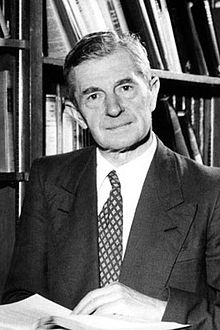Sydney Chapman (astronomer)
| Professor Sydney Chapman | |
|---|---|

Sydney Chapman 1888 – 1970
|
|
| Born |
29 January 1888 Eccles |
| Died | 16 June 1970 (aged 82) Boulder, Colorado |
| Institutions |
University of Manchester University of Cambridge Imperial College London University of Oxford The Queen's College, Oxford Royal Observatory, Greenwich |
| Alma mater |
University of Manchester Trinity College, Cambridge |
| Academic advisors | G. H. Hardy |
| Doctoral students | Franz Kahn George Temple Syun-Ichi Akasofu |
| Known for |
Chapman function Chapman–Kolmogorov equation Chapman–Enskog theory |
| Notable awards |
Fellow of the Royal Society (1919) Smith's Prize (1913) Adams Prize (1928) Royal Medal (1934) The Chree Medal and Prize (1941) De Morgan Medal (1944) William Bowie Medal (1962) Copley Medal (1964) Symons Gold Medal (1965) |
Sydney Chapman FRS (29 January 1888 – 16 June 1970) was a British mathematician and geophysicist. His work on the kinetic theory of gases, solar-terrestrial physics, and the Earth's ozone layer has inspired a broad range of research over many decades.
Chapman was born in Eccles, near Salford in England and began his advanced studies at a technical institute, now the University of Salford, in 1902. In 1904 at age 16, Chapman entered the University of Manchester. He competed for a scholarship to the university offered by his home county, and was the last student selected. Chapman later reflected, "I sometimes wonder what would have happened if I'd hit one place lower." He initially studied engineering in the department headed by Osborne Reynolds. Chapman was taught mathematics by Horace Lamb, the Beyer professor of mathematics, and J. E. Littlewood, who came from Cambridge in Chapman's final year at Manchester. Although he graduated with an engineering degree, Chapman had become so enthusiastic for mathematics that he stayed for one further year to take a mathematics degree. Following Lamb's suggestion, Chapman applied for a scholarship to Trinity College, Cambridge. He was at first awarded only a partial scholarship as a sizar (meaning that he obtained financial support by acting as a servant to other students), but from his second year onwards he received a full scholarship. He graduated as a wrangler in 1910. He began his research in pure mathematics under G. H. Hardy, but later that year was asked by Sir Frank Dyson to be his chief assistant at the Royal Greenwich Observatory. From 1914 to 1919 he returned to Cambridge as a lecturer in mathematics and a fellow of Trinity. He held the Beyer Chair of Applied Mathematics at Manchester from 1919 to 1924, the same position as had been held by Lamb, and then moved to Imperial College London. During the Second World War he was Deputy Scientific Advisor to the Army Council.
...
Wikipedia
